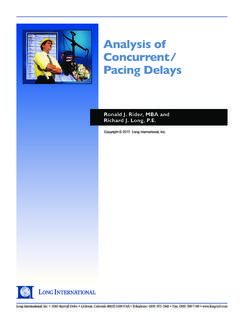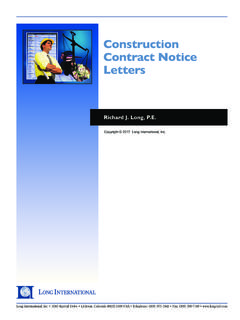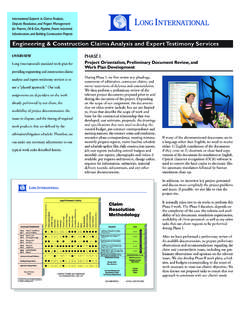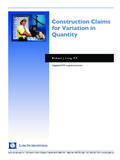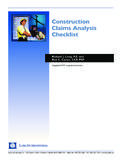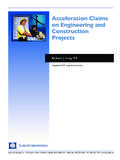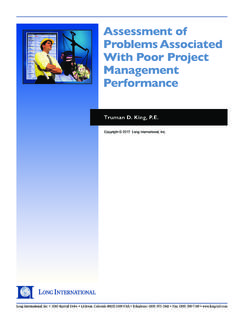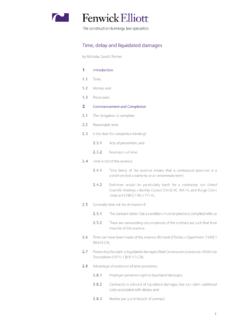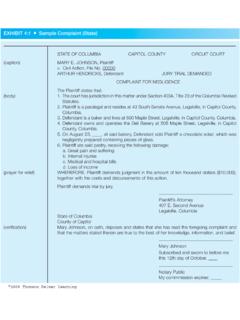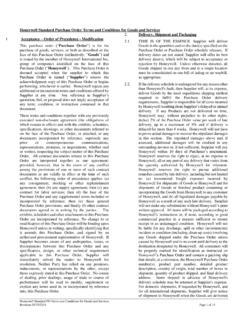Transcription of Richard J. Long, P.E.
1 long Skytrail DriveLittleton, Colorado 80123 -1566 USAT elephone: (303) 972 - 2443 Fax: (303) 200 -7180 long International, Inc. Richard J. long , of Concurrent delay on Construction Claims Richard J. long , Table of Contents 1. INTRODUCTION .. 1 2. CONCURRENT delay DEFINED .. 2 3. TREATMENT OF CONCURRENT delay IN VARIOUS LEGAL JURISDICTIONS .. 5 THE BENCHMARK .. 5 ENGLISH LAW .. 13 SCOTS LAW .. 15 CANADIAN LAW .. 15 HONG KONG LAW .. 15 AUSTRALIAN LAW .. 15 OTHER SOURCES OF GUIDANCE REGARDING THE COST IMPLICATIONS OF CONCURRENT delay .. 16 CONCLUSION .. 17 4. ALLOCATION OF delay RESPONSIBILITY WHEN CONCURRENT delay OCCURS .. 18 AACE INTERNATIONAL S RECOMMENDED PRACTICE NO. 29R-03 FORENSIC SCHEDULE ANALYSIS .. 20 THE SOCIETY OF CONSTRUCTION LAW delay AND DISRUPTION PROTOCOL .. 23 5. FACTORS THAT INFLUENCE THE IDENTIFICATION AND QUANTIFICATION OF CONCURRENT delay .. 25 FUNCTIONAL OR LITERAL CONCURRENCY .. 25 CAUSE OF delay VS.
2 EFFECT OF delay .. 27 FREQUENCY, DURATION AND PLACEMENT OF ANALYSIS INTERVALS .. 30 ORDER OF INSERTION OR EXTRACTION OF delay EVENTS .. 32 HINDSIGHT VS. BLIND-SIGHT .. 32 6. PACING VS. CONCURRENT delay .. 36 7. PRACTICAL GUIDELINES .. 41 Copyright 2017 long International, of Concurrent delay on Construction Claims Richard J. long , Table of Contents (continued) List of Tables Table 1 Concurrent delay Scenarios and Net Effect .. 21 Table 2 Concurrent delay Combinations and Net Effect .. 22 Table 3 Net Effect of Pacing Delays .. 39 List of Figures Figure 1 Illustration of Concurrent Delays .. 3 Figure 2 Concurrent Delays Affecting Activities with Different Float Values .. 20 Figure 3 Illustration of Functional Concurrent Delays .. 26 Figure 4 Illustration of Literal Concurrent Delays .. 27 Figure 5 Illustration of delay -Cause Analysis .. 28 Figure 6 Illustration of delay -Effect Analysis .. 29 Figure 7 Blind-Sight Method for Determining Remaining Durations of Activities in Progress at each Schedule Update.
3 33 Figure 8 Hindsight Method for Determining Remaining Durations of Activities in Progress at each Schedule Update .. 34 Figure 9 Illustration of Direct Pacing .. 37 Figure 10 Illustration of Indirect Pacing .. 38 Copyright 2017 long International, of Concurrent delay on Construction Claims 1. INTRODUCTION Concurrent delay is a vexed and complex technical and legal issue. The challenge is to equitably determine: 1) the contractor s entitlement to a time extension as a result of an owner-responsible delay event (liability) and recovery of the contractor s extended time-related costs (damages) that result from such delays; and 2) the owner s recovery of its actual delay or liquidated damages when the contractor fails to complete its work by a contractual stipulated completion date as a result of a contractor-responsible delay event that is concurrent to the owner-responsible delay event.
4 Construction contracts often do not expressly provide direction as to the parties agreement when there is concurrent delay . Most simply require the contractor to provide notice and specifics when an owner-responsible delay event occurs. The owner then must determine the appropriate time extension, if any, to which the contractor is entitled. However, the owner may be reluctant to grant the contractor an extension of time if the contractor had caused its own delay during the same period. The owner also must consider its position with respect to its actual or liquidated damages as a result of the contractor-caused delay . A dispute may then occur as to whether the contractor is entitled to any extension of time if he also caused delay in the same period. Legal jurisdictions around the world differ as to the treatment of the liability and damages aspects of concurrent delay . To help unravel the complexities of this issue, the following topics are discussed in this article: Concurrent delay Defined; Treatment of Concurrent delay in Various Legal Jurisdictions; Allocation of delay Responsibility when Concurrent delay Occurs; Factors that Influence the Identification and Quantification of Concurrent delay ; Pacing vs.
5 Concurrent delay ; and Practical Guidelines. Copyright 2017 long International, of Concurrent delay on Construction Claims 2. CONCURRENT delay DEFINED The term concurrent delay is commonly used to describe circumstances where different causes of delay overlap during a period of time or schedule As such, concurrent delay could occur during a window if a delay that was caused by the owner2 is on the same activity path or a parallel activity path as a delay that was caused by the If the owner-caused delay and contractor-caused delay affect the same activity or affect different activities on parallel activity paths which are equally critical,4 and as such the owner-caused delay and contractor-caused delay would each have delayed the completion date of the project, the delays are said to be concurrent. For example, as shown in Figure 1, two parallel activity paths are each delayed by five work days during the same window by separate causes, one delay was caused by the owner and the other delay was caused by the contractor, and both affected activities have the same float value.
6 The two 5-work day delays are concurrent. 1 The term window refers to a period of time between two dates in the schedule. The date that define the start or end of a window is called a data date, which is the date on which the schedule is updated for progress. 2 The term owner is applied generically throughout this article for the analysis of issues applicable to the owner or employer of a project. 3 The term contractor is applied generically for the analysis of issues applicable to the contractor of a project. 4 If the parallel activity paths are not equally critical, then the duration of each party s delay and the float value of the affected activities would need to be examined to determine the amount of concurrent delay , if any. Copyright 2017 long International, of Concurrent delay on Construction Claims Figure 1 Illustration of Concurrent Delays This situation is of significance when one cause of the delay is at the owner s risk, while the other, competing cause of delay is at the contractor s risk, and where both causes may be regarded as having caused or contributed to the delay on the project.
7 His Honour Judge Seymour , in Royal Brompton Hospital NHS Trust v. Frederick A Hammond ( ), states: However, it is, I think, necessary to be clear what one means by events operating concurrently. It does not mean, in my judgment, a situation in which, work already being delayed, let it be supposed, because [the Contractor] has had difficulty in obtaining sufficient labour, an event occurs which is a [Employer s time risk event] and which, had [the Contractor] not been delayed, would have caused him to be delayed, but which in fact, by reason of the existing delay , made no difference. In such a situation although there is a [Employer s time risk event], the completion of the works is [not] likely to be delayed thereby beyond the completion date . The [Employer s time risk event] simply has no effect upon the completion date. This situation obviously needs to be distinguished from a Copyright 2017 long International, of Concurrent delay on Construction Claims situation in which, as it were, the works are proceeding in a regular fashion and on programme, when two things happen, either of which, had it happened on its own, would have caused delay , and one is a [Employer s time risk event], while the other is not.
8 In such circumstances there is a real concurrency for causes of the 5 See Royal Brompton Hospital NHS Trust v. Frederick A Hammond ( ), [2000] EWHC technology 39 at 31. Copyright 2017 long International, of Concurrent delay on Construction Claims 3. TREATMENT OF CONCURRENT delay IN VARIOUS LEGAL JURISDICTIONS In this section, the common legal practices regarding the treatment of concurrent delay is summarized in the following jurisdictions: law; English law; Scots law; Canadian law; Hong Kong law; and Australian law. THE BENCHMARK A primary tenet of construction contracts is that there is an implied warranty in every contract that neither party can delay or hinder the timely performance of the other In the case of concurrent delay , it is argued that both parties have delayed or hindered the timely performance of the contract. courts and arbitration proceedings offer three approaches to the handling of concurrent delay : time but no money; apportionment; or responsibility based on a critical path delay analysis.
9 One author writes that the time but no money principle traces back to early 1900s cases when a strict rule against apportionment In one case, the courts could not apportion with any degree of certainty. 8 In another case, the court found that where both parties to a contract are responsible for delay in its performance the court will not undertake to apportion the responsibility for delays. 9 The rule against apportionment was later abandoned because of the frequent use of liquidated damages clauses, the complexity of the contractual relationships, and a belief that the older rule 6 See Hall Construction Company v. United States, 379 559, 564 ( 1966); Gasparini Excavating Company v. Pennsylvania Turnpike Commission, 187 A. 2d 157 162 (Pa. 1963); Felhaber Corporation v. New York, 410 2d 920, 924, 927 (App.)
10 Div. 1978); Jones Constr. Co. v. City of Dover, 372 540 (Del. Super. Ct.) aff d, 377 1(1977); Luria Bros. & Co. v. United States, 369 701,707 177 676 (1966); J. D. Hedin Constr. Co. v. United States, 347 235, 258, 171 70 (1965). 7 See Cocklin, Matthew, International Approaches to the Legal Analysis of Concurrent delay : Is there a Solution for English Law?, Society of Construction Law, April 2013, p. 9. 8 See Jefferson Hotel Co v. Brumbaugh, 168 F 867 (4th Cir 1909). 9 See Greenfield Tap & Die Corp v. US 167, 529, 338 F2d 81 (1964) pp. 87 and 90. Copyright 2017 long International, of Concurrent delay on Construction Claims was too harsh in its Thus, courts will apportion delay damages when evidence permits the segregation of costs resulting from each party s However, courts will not find for apportionment if the segregation of delay costs is Critical path delay analysis offers an alternative to apportionment in that it offers the best evidence of cause-effect analysis of time impacts, as explained in Section 4 herein.

